The following article is republished with permission from SECORE.
Coral reef restoration – limitations, challenges and opportunities
by Dr. Carin Jantzen
Things don’t look good for corals. With only a few truly healthy coral reefs left and forecasts not getting any better, it may be a tight squeeze for many reefs to live to see the next century. The call for action may already be earpiercing, so what can we do to counteract the decline of coral reefs?
Climate change, especially increasing sea water temperatures (IPCC: impacts on coral reefs), as well as human-induced stressors, such as unsustainable fishing and pollution, are giving corals a hard time. The 3rd global bleaching event wiped out corals at alarming scales. For instance, over 90% of the great barrier reef is affected by bleaching and more than 22% of the corals have subsequently died so far. Till now, our efforts to deal with climate change, overfishing, pollution and other threats have failed to even slow down the decline of coral reefs.
In recent years, the potential to use active coral restoration as an additional tool for coral reef management has gained increasing attention; among scientists, MPA managers and local stakeholders, as well as in the media. But can we really ‘replant’ damaged reefs with corals―and if so, how can this be accomplished and on what scale?
Photo: coral reefs, Curaçao, all screenshots from SECORE International – The Film, ©Vanessa Cara-Kerr (Reef Patrol) top) reef aerial view; below left) lively reef site; mid) devastated reef site with dead coral skeleton rubble; right) little blennie hiding within coral tentacles
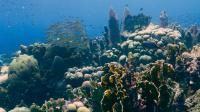 | 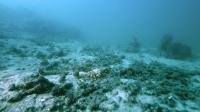 | 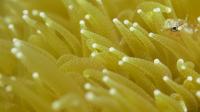 |
SECORE International – The Film
Coral reef restoration today
Like all animals, corals need to grow and reproduce and a damaged reef can only recover in doing so. Corals have two ways of reproducing, either asexually when fragments of a colony grow again, or sexually by spawning eggs and sperm or by releasing larvae. Some coral reefs do not have the ability to recover on their own anymore.
Coral reef restoration is the process of transplanting corals to ‘reforest’ a desolated reef. This may sound straightforward, but it is not. Although a lot of knowledge and hands-on practice has been developed, actual coral reef restoration is still in a fledgling state―in terms of practice and scientific research.
A common practice is called asexual coral restoration, whereby the coral’s ability of asexual propagation is used. You can get fragments from donor colonies by breaking off pieces, usually taking not more than 20% of a colony. The resulting fragments are clones of the donor colony. Sometimes you are able to use already broken off pieces, for instance, when branching corals are fractured by a storm. Then, you usually keep your fragments in different kinds of nurseries for some months. During this time, the fragments heal and grow and are well-cared for. Finally, you transplant the young corals on the reef or elsewhere, using underwater glue, cable-ties or nails to provide initial attachment. If successful, the coral transplant will eventually overgrow the surrounding substrate and will self-attach to the reef.
“The nice thing about coral restoration using asexually propagated fragments is that local communities can do it. There are already small local community groups doing coral transplantation in many places in the Pacific and Indian Oceans. If it’s done properly, it can be very useful. The problem is that there are very few places in the world where you can show that this effort has had any long-term ecological impact. A positive example is the recent work done by Nature Seychelles on Cousin Island”―Large-scale coral reef restoration could assist natural recovery in Seychelles, Indian Ocean. “But, if you look at many such coral restoration efforts, initially they look fine, even after one or two years, but too often at some point, something goes wrong and the restoration fails”, says Prof. Alasdair Edwards of Newcastle University, who has worked on coral reefs for almost 40 years and spearheaded the ‘Reef Rehabilitation Manual‘―a compilation for managers. He recently became a member of SECORE’s Science Board.
Why are those approaches so rarely successful? The method itself doesn’t seem to be overly difficult to accomplish. “The biggest danger with asexual restoration is that humans are making ecological decisions and bypassing natural selection. You assume this coral colony or that one is well adapted to the transplant site environment. You think they should be, nevertheless, you don’t know for sure. Even if you use a wide range of genetically different individuals in order to maintain genetic biodiversity, these fragments never went through the initial period of intense selection at that site, like any sexual recruits settling on the reef would have done”, explains Alasdair. One should thereby keep in mind life is hard for little coral recruits; in the wild, only about 1% will survive the first few months of their life!
Photos: asexual coral restoration by Coral Restoration Foundation Curaçao (CRFC) supported by Ocean Encounters, all ©Pol Bosch left) staghorn coral fragments on tree-shaped nursery & mid) growing coral fragments on metal structure & right) coral fragments fixed to boulder; below) natural staghorn coral patch, Curaçao, ©Paul Selvaggio (Pittsburgh Zoo & PPG Aquarium)
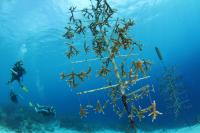 | 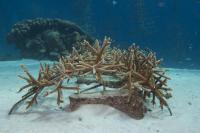 | 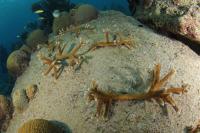 |
Selection and asexual restoration
Natural Selection ensures that organisms living in an environment are adapted to the surrounding conditions. It’s a process whereby less well adapted individuals fail to produce as many offspring as their more competitive neighbors―during the ‘struggle for existence’. In the long run, this can result in populations being highly adapted to their local environment.
There is a simple example from the Fiji islands that illustrates the importance of local adaptation for restoration. At Moturiki Islands, corals on the reef flat died after bleaching events in 2000 and 2002. The local community was concerned and wanted to replant them. Unfortunately, there were no corals left on the reef flat that could be fragmented and used for a restoration effort. So they had to take them from somewhere else; from a deeper reef site, thus from a different environment where corals are not adapted to life on the reef flat. First, the out-planted fragments were doing fine, but when the warmer seasons started, all transplanted corals on the reef flat bleached and died (for more info see: Reef Rehabilitation Manual).
Why is it important to maintain genetic diversity?
Genetic diversity means to have different varieties of gene combinations, so-called genotypes, within a population. There are important reasons to maintain genetic diversity: a diverse population is more likely to survive disease out-breaks or other stresses, as some genotypes may be more resistant than others and may survive. Every time a population reproduces sexually, a new batch of genotypes is produced by recombination―by reshuffling the genetic pack so to say. And genetic diversity is a prerequisite for natural selection to do its job. Recombination may coincidentally equip some offspring with genotypes, which could better adapt to prevailing conditions than their struggling parents.
That doesn’t necessarily mean you cannot maintain genetic diversity with asexual coral restoration approaches. Studies suggest that if you collect fragments from 30-35 genetically different colonies of a coral species at a reef site, they will represent over 90-95% of the genetic diversity for the species at that site. During restoration work, you need to make sure a diverse set of genotypes will be represented in any transplantation effort. Once your corals start to reproduce sexually, your new coral generation will have all the genetic diversity you wish for―but only then. A mass spawning of transplanted corals occurred on Okinawa, Japan, where 2800 transplanted branching corals spawned in 2015.
Environmental education
Asexual coral restoration has the great potential to function as a tool to raise awareness among local communities and stakeholders. Snorkelers and divers can visit nursery sites and look at newly planted corals. Getting tourists aware and people on-site committed to take part in local conservation projects is a crucial requirement to make any environmental protection and restoration effort last. In the Maldives for instance, many resorts successfully use restoration efforts to educate tourists. Another example is the work done by Expedition Akumal: they use small, already broken fragments of staghorn corals for restoration purposes and raising awareness among divers is part of their effort.
Photos: left) many individual coral colonies on a reef flat, Guam, ©Paul Selvaggio; mid) hotspot of biodiversity: the coral triangle, Philippines, ©Bart Shepherd (California Academy of Sciences); right) environmental education with asexual coral restoration approaches by CRFCuraçao and Ocean Encounters, ©Pol Bosch
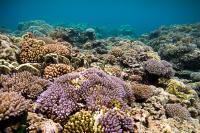 | 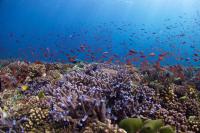 | 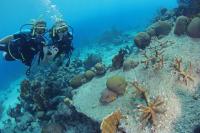 |
Sexual restoration
An alternative approach to produce corals for restoration is sexual coral restoration: studied and further developed by SECORE and partners during the last decade, it takes advantage of corals’ sexual propagation. To put it simply, you collect coral gametes―eggs and sperm―either in the field or from corals that you have brought to your lab facilities for that purpose. Once you have your gametes, you let them fertilize and raise the developing coral larvae. When the larvae are ready and competent to settle, you provide them with the right settlement substrates and wait till they have settled. Ideally, you let them grow in a mid-water nursery at the reef to a certain size, a process which may take weeks to months, before transplanting them onto the reef.
There are two big differences using sexual approaches compared to asexual ones: each of your baby corals is genetically unique and you have to grow your corals from the start.
Photos: sexual coral restoration left) collecting coral spawn at the reef, ©Paul Selvaggio; mid) collecting coral spawn in the lab & right) coral embryos under the microscope & below) coral recruits on settlement substrate, all ©Mike McCue (Underwater World Guam)
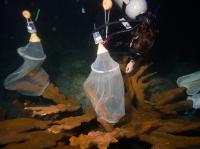 | 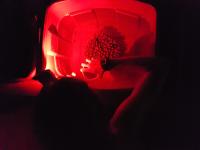 | 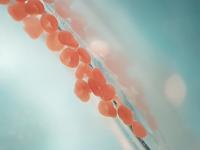 |
Asexual versus sexual approaches
“Both techniques have their merits and disadvantages”, reflects Dr. James Guest. James is a coral reproduction and restoration expert in South-East-Asia, with a special interest in studying coral reef resilience. James is currently based at the Hawai’i Institute of Marine Biology and has been a SECORE Science Board member since 2012. “Asexual propagation is less expensive on small scales and can be done with relatively little training. With sexual propagation you get sexual recombination and you get lots and lots of babies; out of one spawning event you could potentially get a million corals―producing a million fragments would be quite a challenge. We need to be prepared to adopt both approaches, or a combination of both. Like when coral colonies are far apart, you could use fragmentation to create a broodstock. You can also keep track of who their parents are to maintain genetic diversity. When your broodstock spawns you can get sexually propagated offspring. You could get some quick results using asexual propagation and then some longer term results with sexual propagation.”
“Naturally settled corals start life as tiny single polyps, one mm or so across. By the time they reach the size of a transplanted coral fragment, they will have already undergone a long period of selection, probably years, within the reef environment”, explains Alasdair. “Sexually propagated corals reared for restoration enter the reef environment later, but are still subject to a long period of natural selection such that by the time they reach the size of a transplanted asexual fragment―for instance 7-10 cm―you can be pretty sure the survivors are well adapted to the environment at the site.” And for those who have died: at least no coral was harmed to obtain them.
Working hand in hand
A good example how to combine both techniques are the ongoing research and restoration efforts for the endangered staghorn coral on Curaçao.
The staghorn coral (Acropora cervicornis) tends to have fairly brittle branches and to form relatively big ‘thickets’ by asexual propagation; for instance when storms break those corals apart. Due to its scarcity today, the patches are too far apart to collect the spawn of genetically different parents that would be able to fertilize during one spawning event―corals with the same genotype usually do not fertilize each other. Until now, it was therefore not possible for SECORE and long-term partner Carmabi Research Station to raise sexually propagated corals.
Then, in 2015, the Coral Restoration Foundation Curaçao (CRFC) supported by Ocean Encounters (A local dive school) started an asexual coral restoration project. It includes the growth and transplantation of the endangered staghorn coral on Curaçao. The CRFC collected already broken pieces of staghorn corals and put them in nurseries that have a tree-shaped form, so-called ‘coral tree nurseries‘. The fragments on the nurseries came from different reef sites and thus most likely represent different genotypes.
Driven by the idea that coral fragments on the tree nurseries could be used as broodstock for sexual propagation, the different groups joined forces. And during 2016’s coral mass spawning in August, the fragments spawned! A joint diving team collected staghorn coral gametes, brought them back to the lab and fertilized them. Now, a new generation of sexually propagated staghorn corals is growing in a nursery as well.
CRFC is currently out-planting the asexual propagated tree-nurseries’ fragments in front of the Curaçao Sea Aquarium, where they can be visited by their own divers and diving tourists alike. They fix the fragments to the ground with different techniques, such as epoxy-glue and nails. CRFC also built metal structures to which the fragments are cable-tied, as well as using rebars to fix single colonies on unstable substrate.
Photo: staghorn corals on tree nurseries, Curaçao, all ©Pol Bosch left) spawning of fragments; mid) collecting coral spawn with nets; right) collected spawn in sample vial
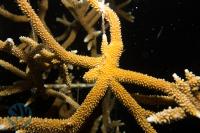 | 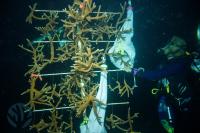 | 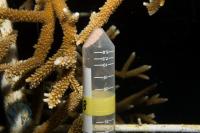 |
Where to plant your corals
Regardless of the technique used, it is essential to choose your restoration site well. If you find a reef devastated, it obviously died for a reason or rather several thereof. Unless you make sure those reasons have been eliminated or are at least under control, it’s not a good idea to start any restoration effort there: your new corals are unlikely to survive. Best chances may be had in well-managed areas where stressors like overfishing and pollution are as low as possible and grazers―herbivores―are present. “If you have overfishing, removing the herbivores, that’s not a place where you want to try restoration. Managing local fishing practices is important; in some areas, restrictions of fishing of herbivorous fish might be sufficient to make the reefs more resilient without the need for costly restoration. Accordingly, you will have more success in restoration, where you have a relatively healthy herbivore population”, emphasizes James.
Up-scaling – how to get real?
Till today, any attempts to restore reefs have occurred on a relatively small scale. Considering the scale at which coral reefs dwindle away, efforts don’t seem to be sufficient at all. You do not only need the right method, or a combination thereof, but you also need to think about working on a larger scale.
“For scaling up, the best chance may be with the sexual route”, says Alasdair. “Settling corals on some sort of substrate, a substrate that can be easily put out on the reef, either self-attaching or one that can be readily attached, depending on the environment. At the moment, the biggest challenge is the huge mortality in the first few months after settlement; usually over 95% die within four months or so.” Keeping in mind that this mortality is a natural one and only very, very few coral larvae will become an adult coral in the wild.
“We are quite good at the first stages, keeping gametes and larvae alive in captivity, keeping them in good conditions, letting them settle. You may get millions of larvae out of one spawning event”, says James. “But at some point mortality rates start to rise. You will never be able to reduce all the mortality, but we need to develop methods to get to a point, where almost all substrates have at least one surviving coral. We are actually doing pretty well, we get quite good post-settlement survival, but if we could improve this a bit more that would really help with scaling up. And the second thing is, we still have to get them on the reef.”
So far, each fragment or substrate bearing a coral recruit needs to be transplanted to the reef by hand. For those of you who are not scuba divers, diving involves quite some logistics and equipment and any work under water is additionally limited by the amount of air in your tank. That’s why out-planting corals is the biggest cost and time intensive part of any restoration effort.
To overcome this limitation, SECORE together with the California Academy of Sciences and other partners such as the Reef Systems Academic Unit (UASA, department of the Universidad Nacional Autonoma de Mexico, UNAM) are currently testing new coral settlement substrates that can self-attach to the reef. They may not be suitable in all settings, but when starting a restoration effort you commonly still have a reef framework with little crevices and alike where those substrates can get caught up. SECORE and partners like the Shedd Aquarium are also developing new devices to raise coral larvae on a larger scale outdoors; ideally at a sheltered pier or alike. They are in the testing phase right now―in a few months we will hopefully learn how useful they are!
Photos: developing large scale techniques, all ©Paul Selvaggio left) preconditioning of coral settlement substrates & mid) adding ready-to-settle coral larvae to pools with substrates, both Workshop Mexico 2015; right) construction floating barge cultures for larvae rearing & below) floating barge cultures in action−as well as is Mark Schick (Shedd Aquarium), both Workshop Curaçao 2016
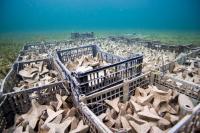 | 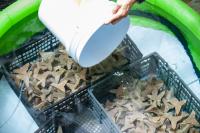 | 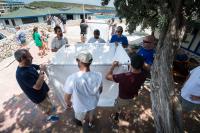 |
Assisted evolution or what about Supercoral?
Assisted evolution means selecting specific traits, doing artificial selection―breeding―such as hardening plants against pests or bugs. There is the saying what doesn’t kill you only makes you stronger―if you coped with a certain situation, you will likely cope with a similar situation more easily in the future. So, is there a way to harden your corals?
“What people do under the umbrella of assisted evolution is to give coral recruits some kind of stress, for instance raised temperatures, that doesn’t necessarily kill them, but does acclimatize them”, explains James. “When you undergo stressful events you undergo changes that will prepare you for the next stressful event. And there is even the possibility that they become changes that you can pass on to your offspring. It would make sense for very long living organisms and a coral colony may live for hundreds of years. You may not even need to really stress them, but to put the coral settlers in a more variable environment. For instance, you might have two corals that live in places which have the same average temperature, but one of them lives in a place where the variation over the day or the year is much bigger. The corals that live in that type of environment with more variation tend to deal with stress that does go above the average a bit better.”
So your corals shouldn’t feel too comfortable during their early life as settlers. “That’s always the worry with rearing something in nurseries. If the nursery environment is too cushy or different from the outplant site, when the corals are transplanted to the reef they may have problems. It happens with plants as well. Some greenhouse reared plants do not prosper when planted out in gardens and nursery reared trees may not survive well in the wild where deer can get at them”, says Alasdair.
Recently, the term ‘super coral‘ has appeared in the media repeatedly. It means to breed corals that are more resilient, that is they do well under higher than usual temperatures caused by rising sea water temperatures (in turn caused by climate change), but do not experience any other relevant impairment for that. But usually there is a trade off for everything; you cannot always be first: if you are good at some things, you are bad at others. “A recent paper doing modeling work, showed that corals that were bleaching tolerant could actually do worse after a bleaching event”, tells Alasdair. “Because the critical thing about recovery after a bleaching event is the speed of growth. If your growth is impaired you don’t recover fast enough; you may be outcompeted by algae and go extinct quicker.”
If such ‘super corals’ exist, we do not know yet. Working with assisted evolution in corals is likewise a new research field. Renowned scientists like Prof. Ruth Gates and her lab are on to it―so we should learn more about that in the next few years.
Photo: sexually derived and outplanted elkhorn coral, 5 years old; no Supercoral, but a super beautiful coral―albeit of an endangered species, ©Paul Selvaggio
Is there a future for coral reefs?
A most haunting question for coral reef lovers and environmentalists. ”Some corals will definitely survive”, says Alasdair, “but whether coral reefs as a productive ecosystem will survive the next century is a moot point. In the end, the only way to ensure the productive and beautiful coral reefs we know and love will survive is to reduce greenhouse gas emissions and solve the problem of global warming. It is also essential that we improve management of local scale stressors such as overfishing and coastal development. If not, then coral reefs will be among the first big ecosystems to go, with devastating consequences for the hundreds of millions of humans who depend on them.“
Thus, there may be two reasons why restoration plays an important part in helping to preserve coral reefs for the future: by helping to keep some pockets―refuges―of healthy coral reefs and by maintaining ecological functions where possible in the meanwhile. “There will be places where they do survive much better”, Alasdair continues. “The longer you can maintain some healthy coral communities, the more chance people will solve the key issues. You need pockets of healthy coral reefs, otherwise there is nothing to spread from. I think all the reef restoration efforts are clearly worth it and it’s very unlikely that it all will be totally in vain.”
There couldn’t be any better closing remark: to continue our efforts and to not lose hope!
Saving coral reefs.
Photos: all ©Paul Selvaggio left) Alasdair Edwards at SECORE board meeting 2016; mid) James Guest with coral offspring, Workshop Guam 2013; right) Carin Jantzen (PR SECORE) after exploring to-be spawning site, Workshop Curaçao 2016; below) Caribbean reef site, Curaçao
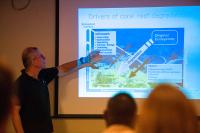 | 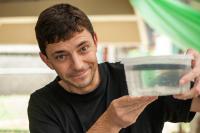 | 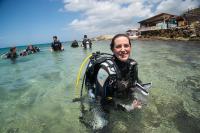 |

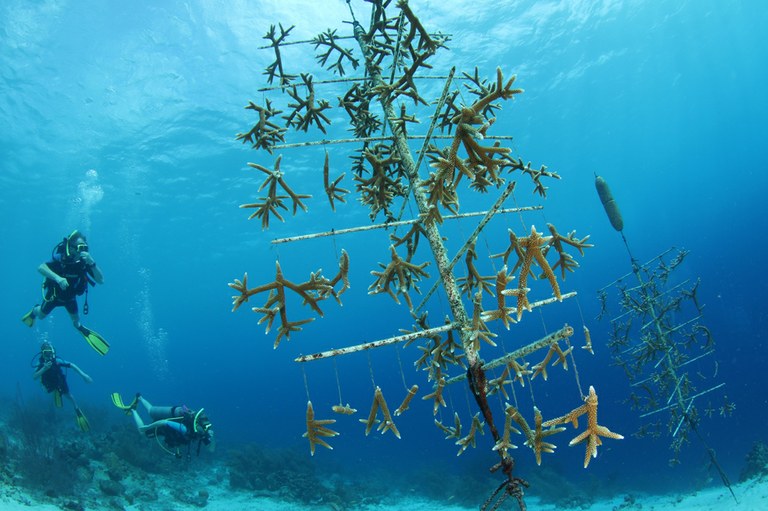
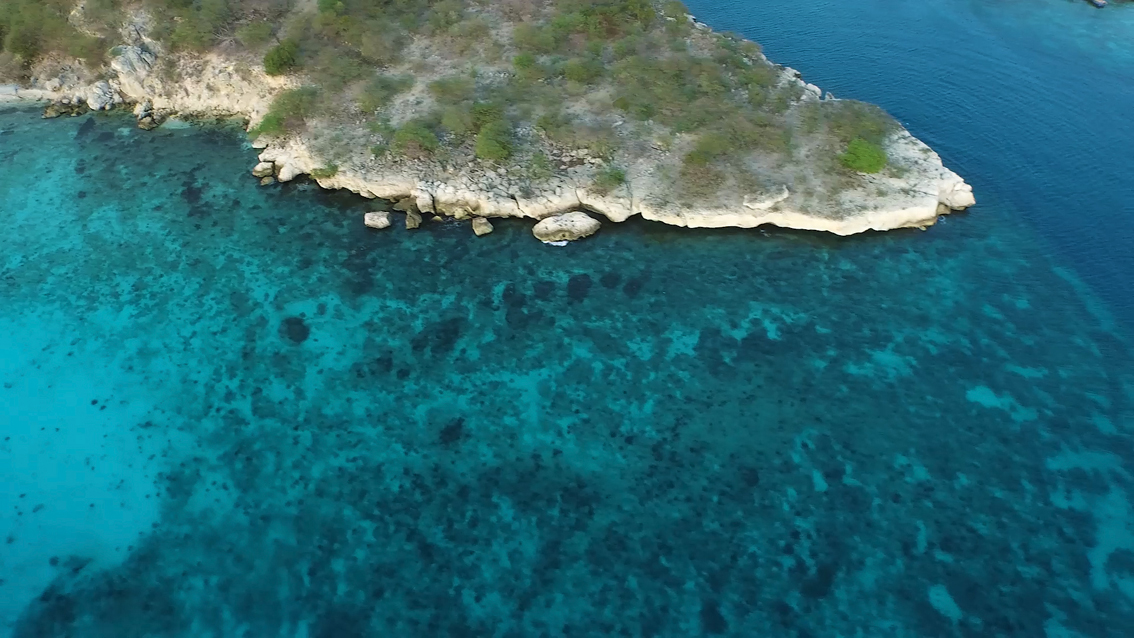
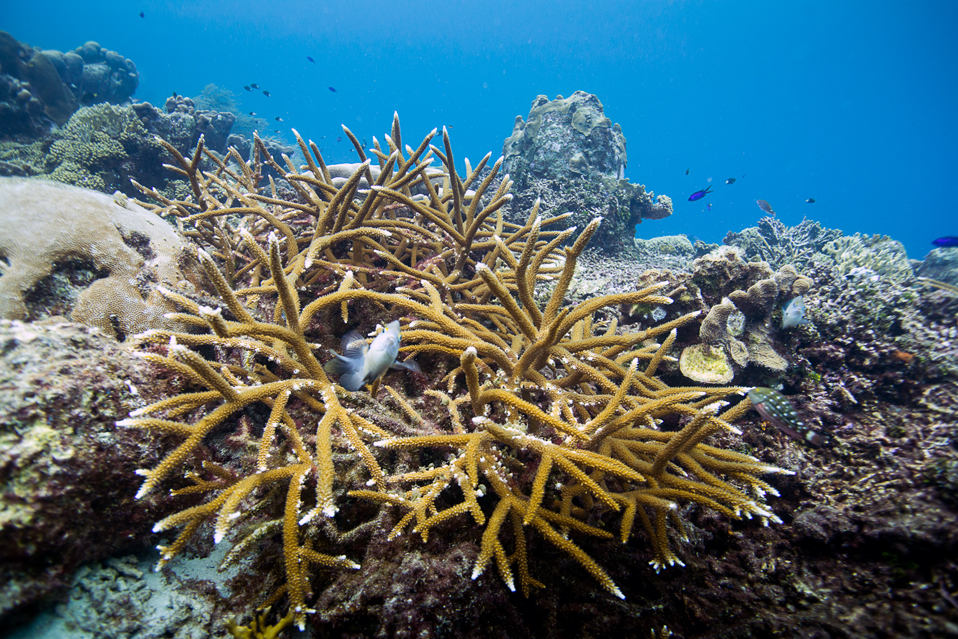
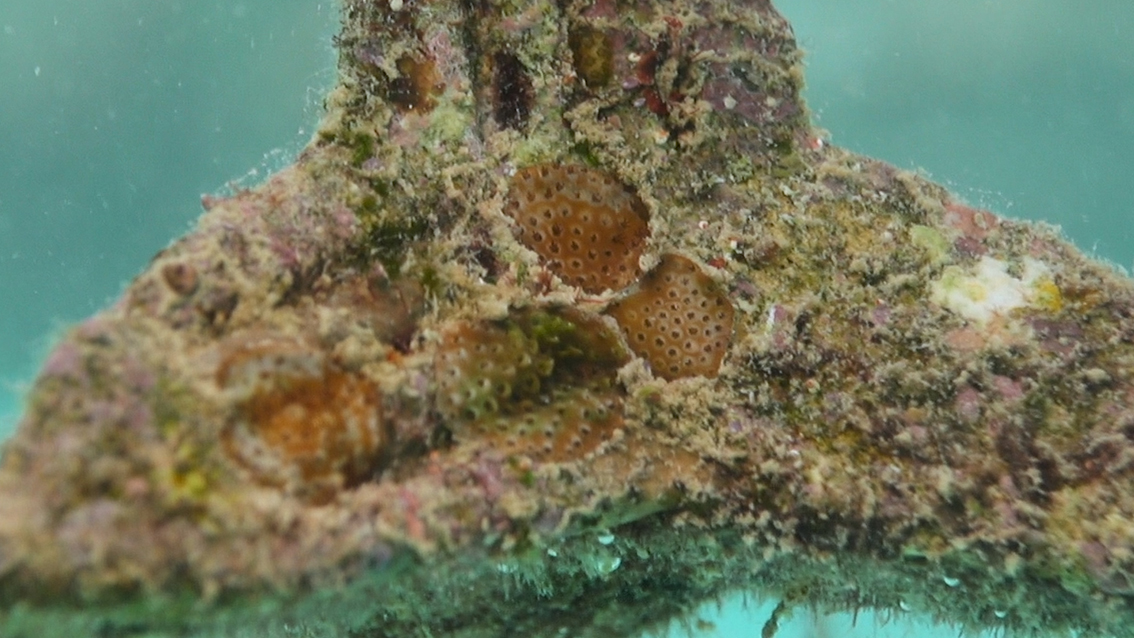
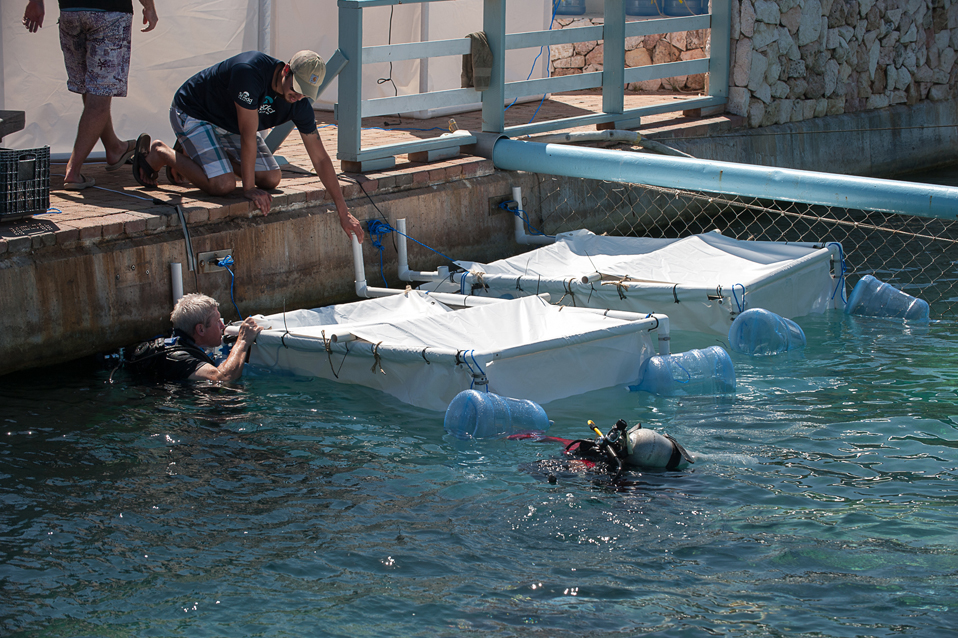
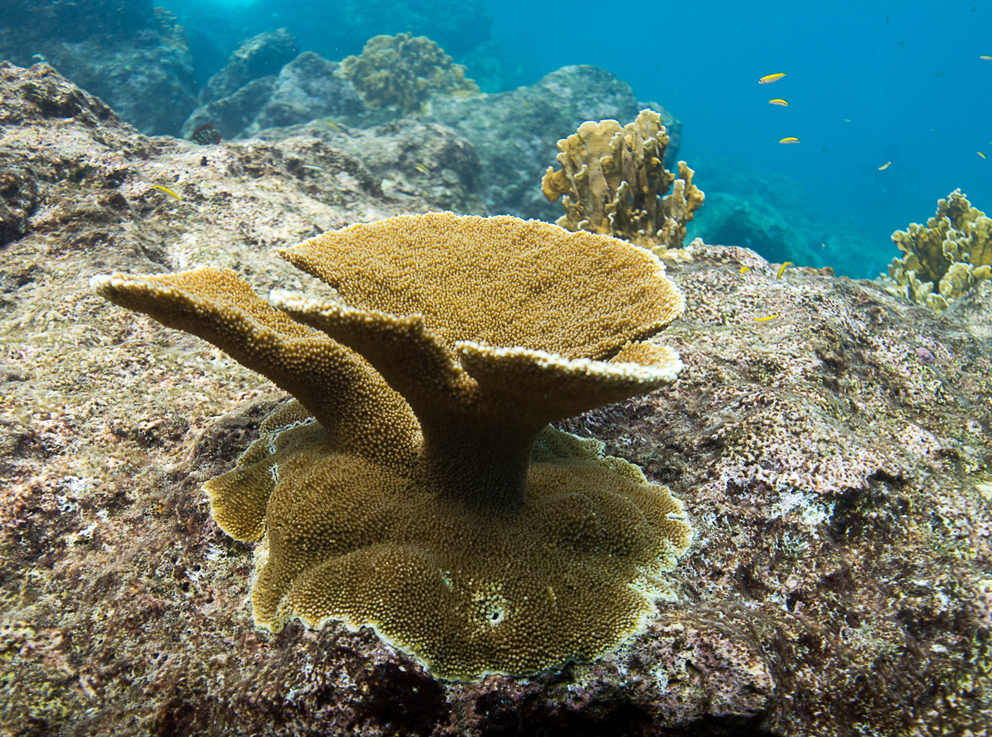
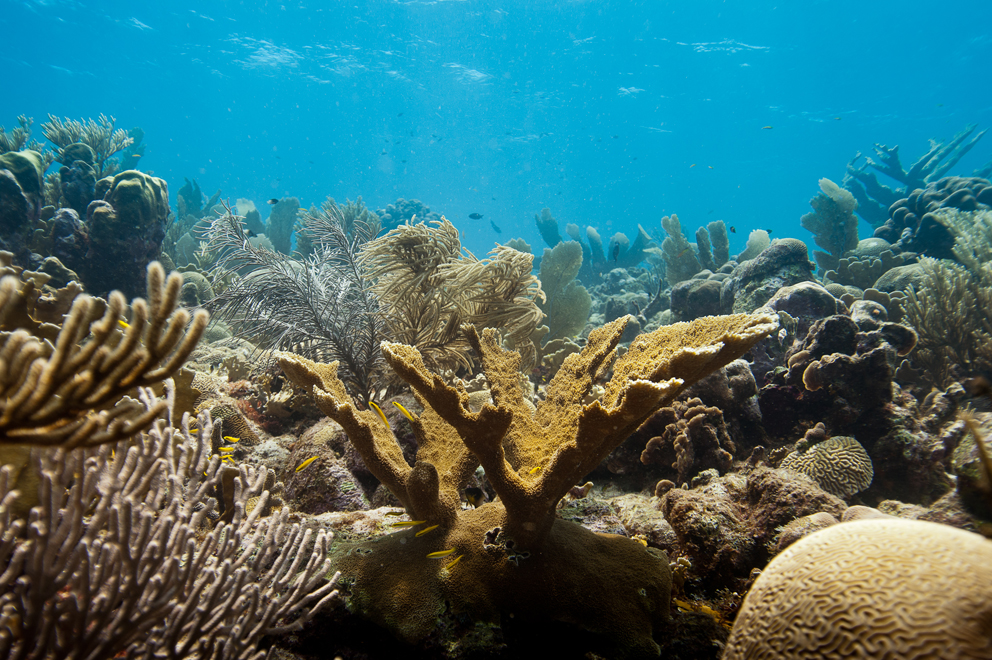









0 Comments